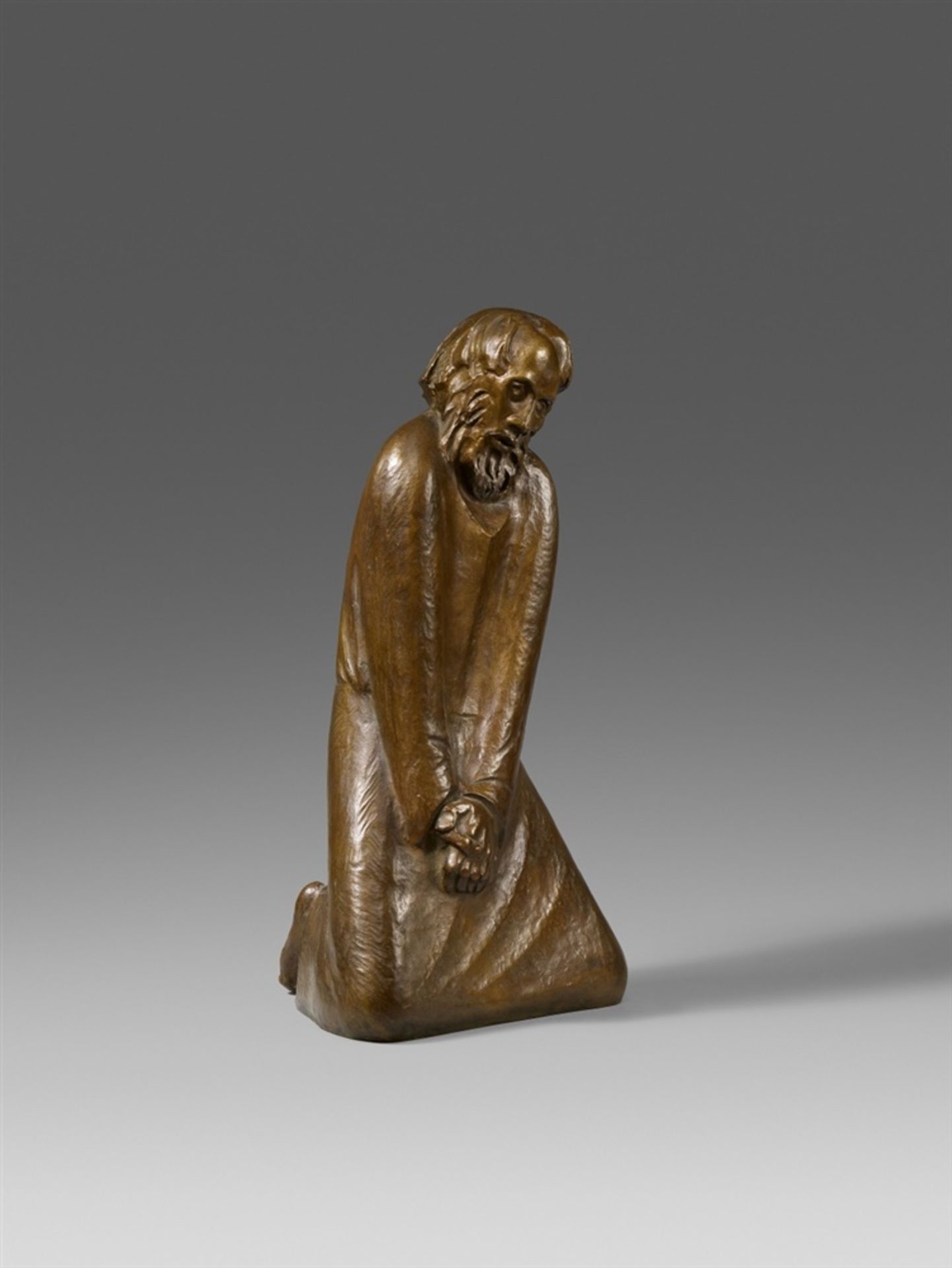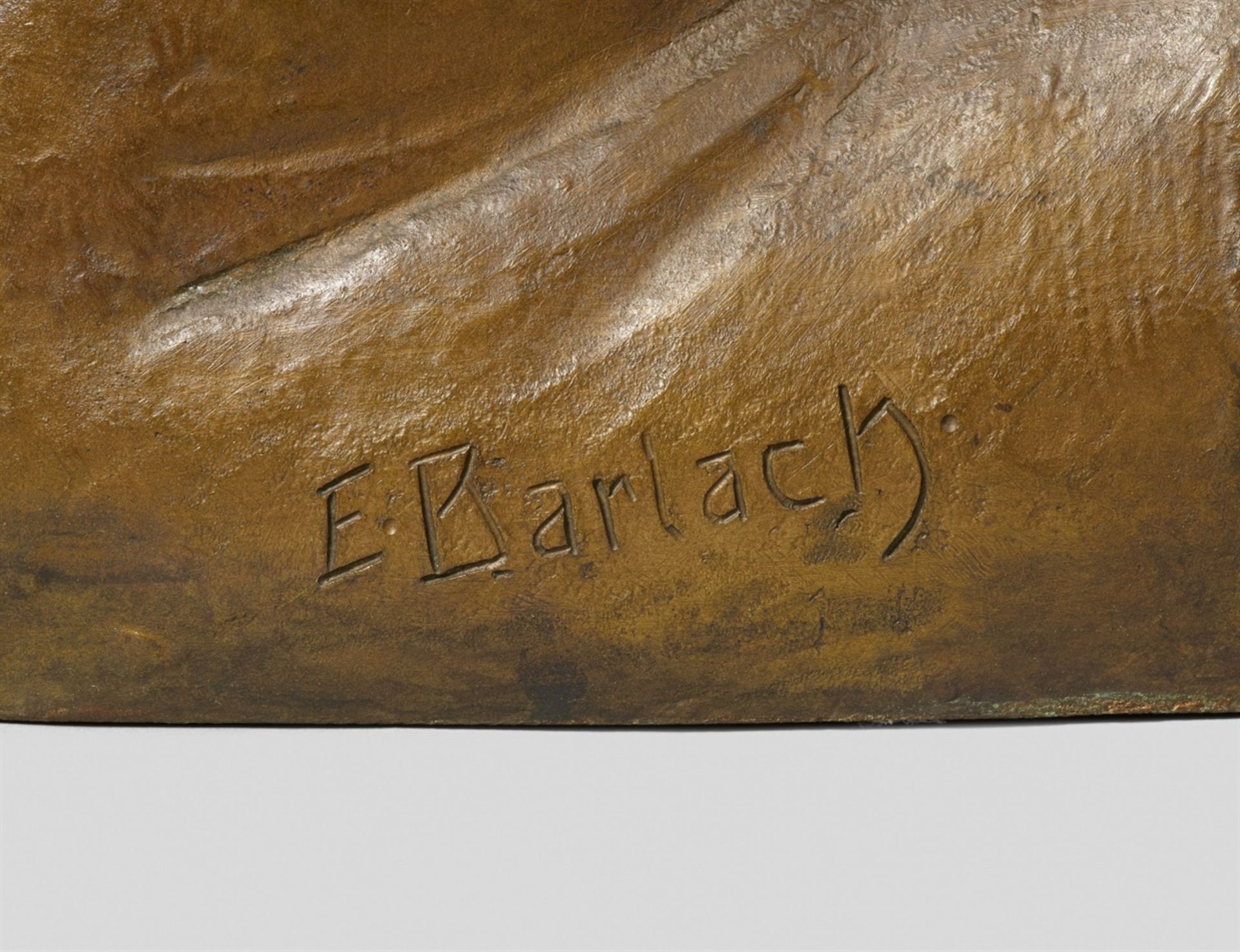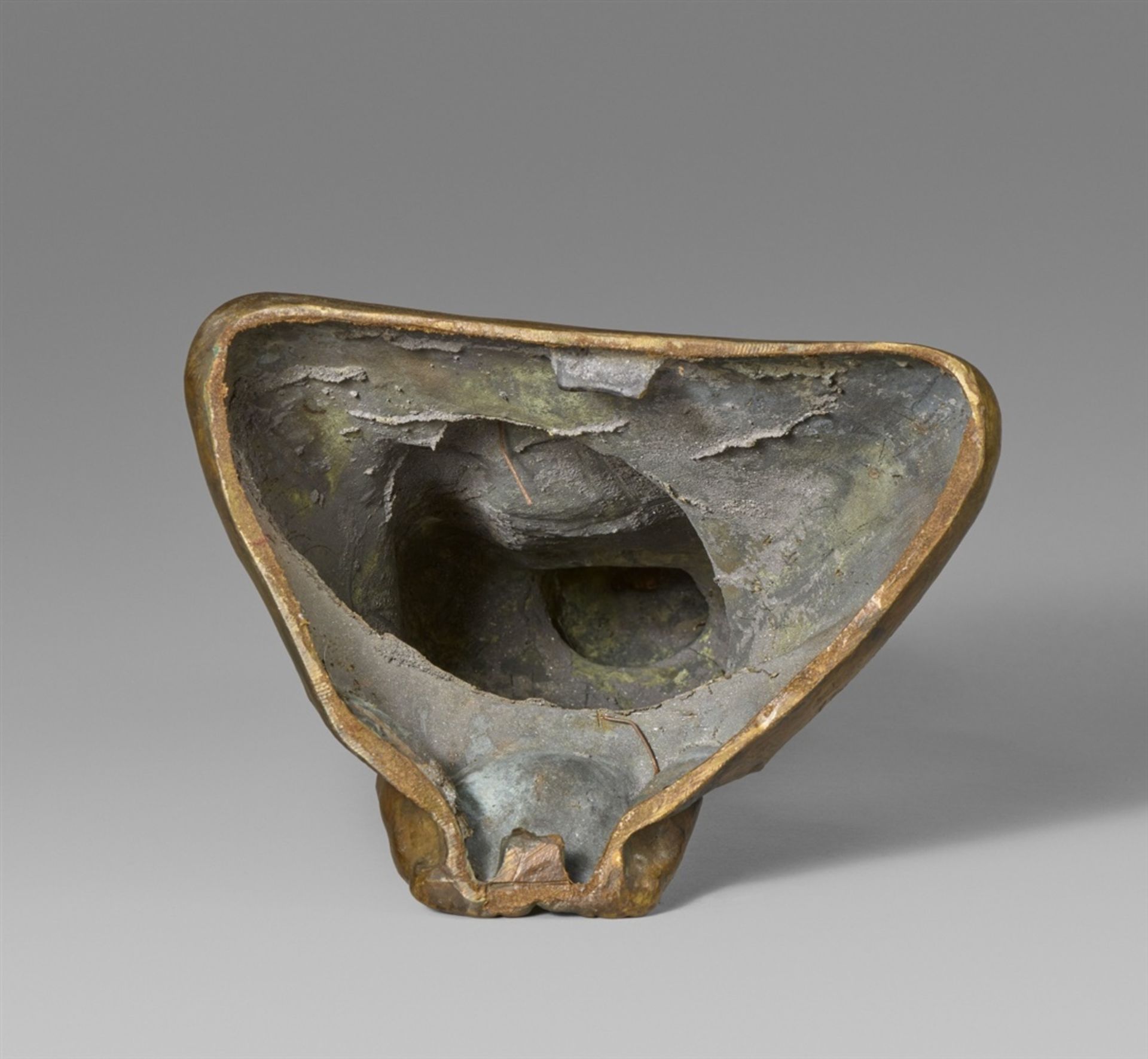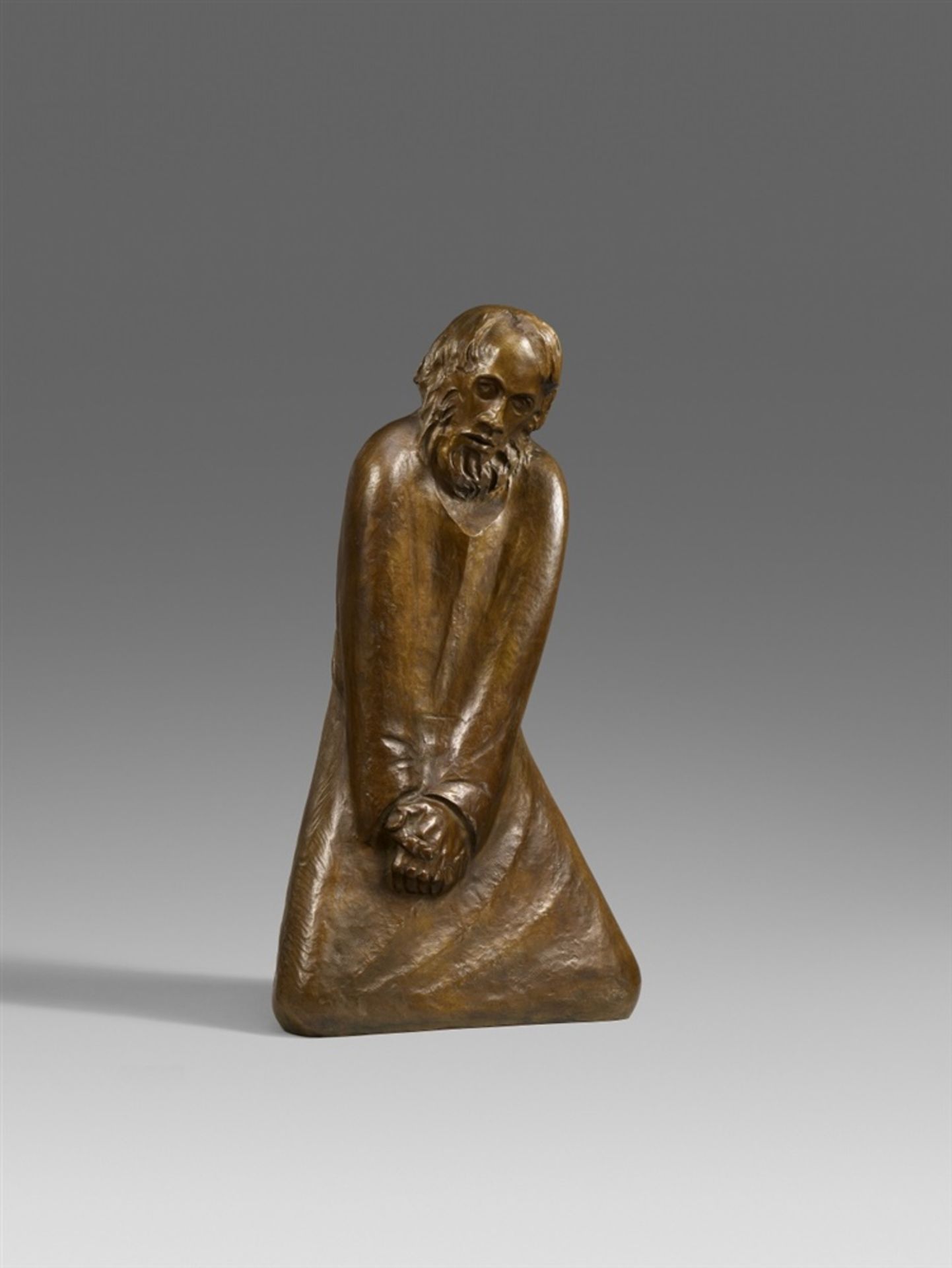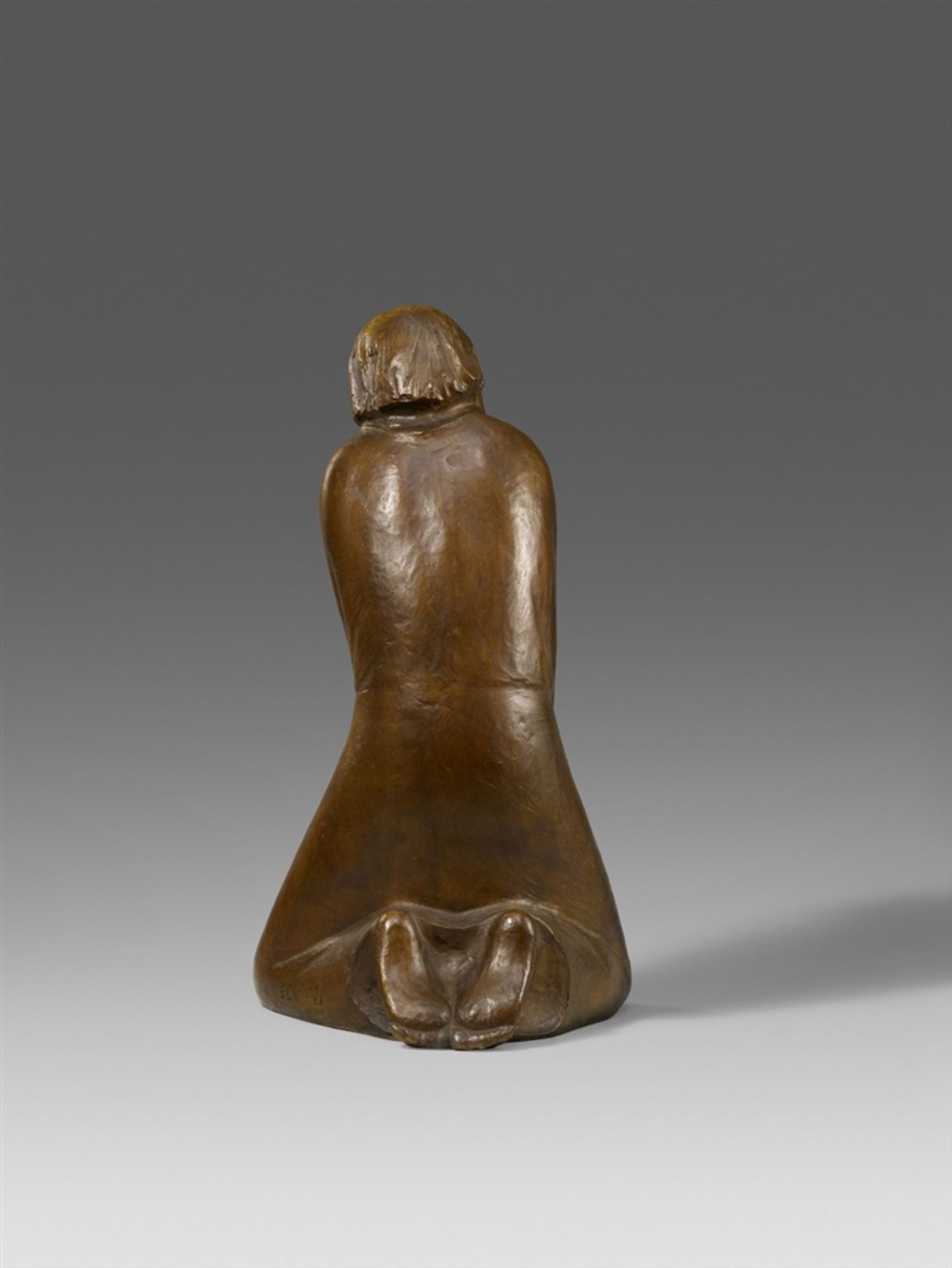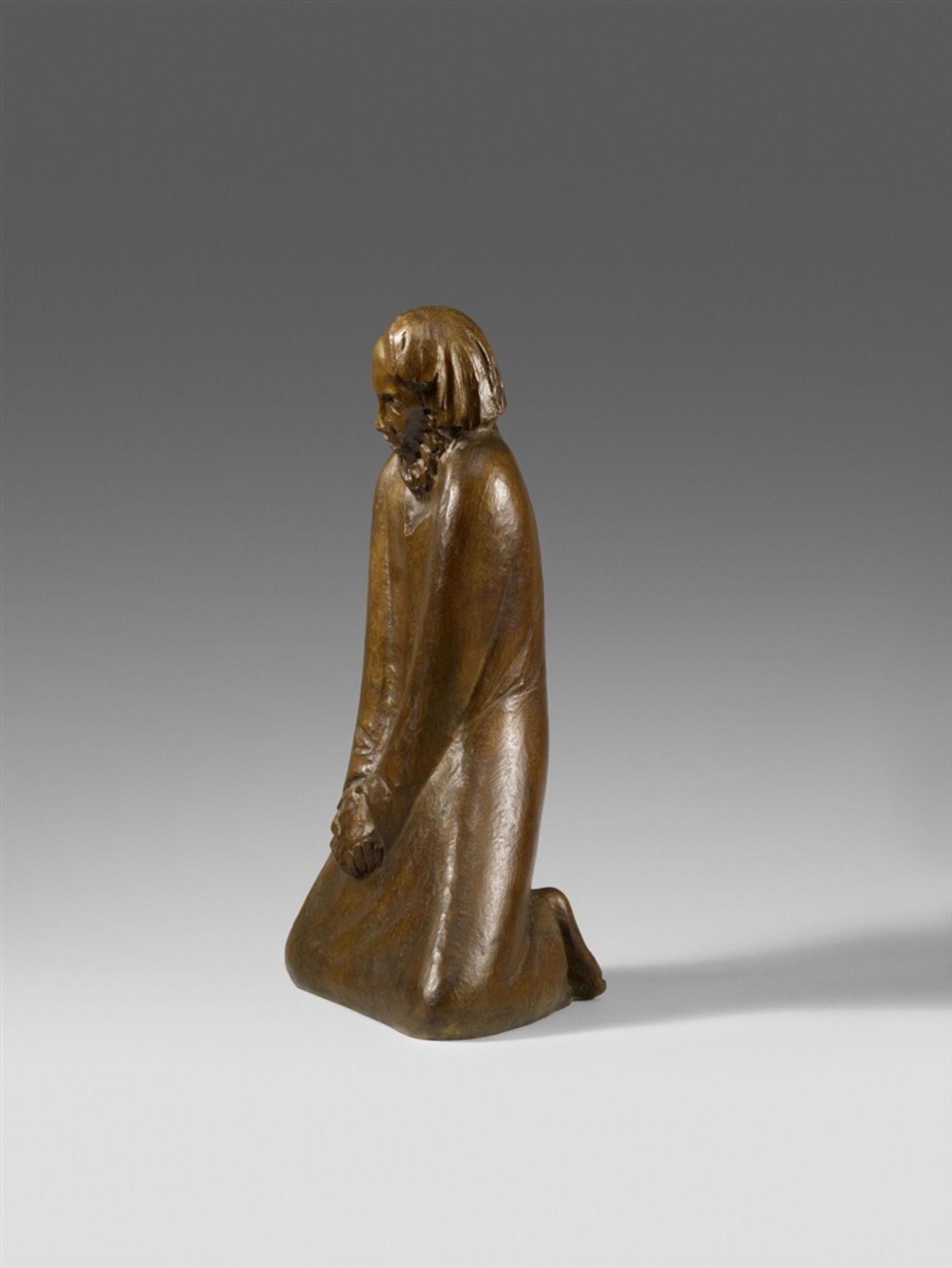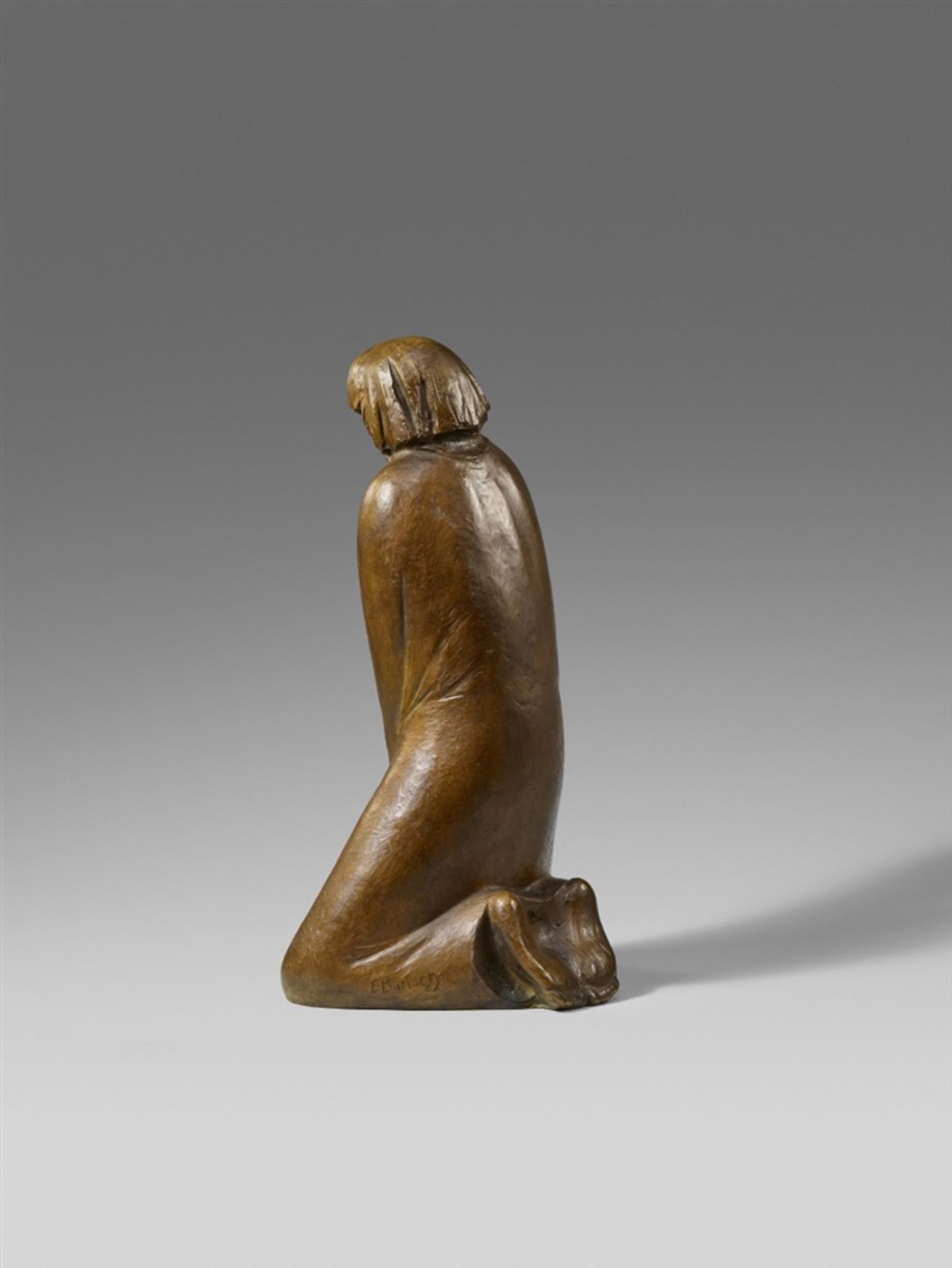203
Ernst BarlachDer Zweifler
Ernst Barlach
Der Zweifler
Bronzeplastik Höhe 50,7 cm Rückseitig unten rechts signiert 'E.Barlach'. Vorkriegsguss aus einer bei Laur genannten Gesamtauflage von 46 Exemplaren, davon 17 Güsse vor 1938 entstanden. - Mit schöner, ebenmäßiger bronzefarbener Patina, stellenweise leicht aufgelichtet. - In guter Erhaltung.
Laur 470; Schult 385
Wir danken der Bildgießerei Hermann Noack, Berlin, für freundliche Auskünfte nach Vorlage des Originals.
Provenienz
Ehemals Sammlung Adolf und Margarete Vogler, Hamburg (vor 1945 erworben); Margarete Vogler, Nachlass; seitdem in Familienbesitz
Ausstellungen
U.a. Berlin 1931/1932 (Galerie Alfred Flechtheim), Weihnachten 1931 - Wilhelm Lehmbruck, Ernst Barlach, Rudolf Belling, Renée Sintenis, Kat. Nr. 18 ("Der kniende Mann") mit Abb. S. 5; New York 1938 (Galerie Buchholz); Berlin 1948 (Galerie Franz), Kat. Nr. 25, S. 22, mit Abb. S. 17; Hamburg 1948 (Galerie Hoffmann), Ernst Barlach Gedächtnisausstellung zum 10jährigen Todestag, Kat. Nr. 18; Düsseldorf 1951 (Galerie Alex Vömel), Ernst Barlach, Kat. Nr. 20; Kassel 1955 (Documenta I), Kat. Nr. 23; Bremen 1959 (Kunsthalle), Ernst Barlach, Kat. Nr. 38; Schleswig 1989 (Landesmuseum Schloss Gottorf), Ernst Barlach. Denkzeichen, Kat. Nr. 62; Bergen/Güstrow 2000 (Kunstmuseum/Ernst Barlach Stiftung), Ernst Barlach. Ein Graphiker und Bildhauer des deutschen Expressionismus, Kat. Nr. 95
Literatur
U.a.: Elisabeth Laur, Exkurs: Bronzeplastiken im Werk Barlachs, in: Ernst Barlach. Das plastische Werk, Ernst Barlach Stiftung Güstrow 2006, vgl. S. 43, 45; Volker Probst, Die Bronzen im Werk Ernst Barlachs, in: Posthume Güsse, Bilanz und Perspektiven, Arp Museum Bahnhof Rolandseck, Berlin/München 2009, vgl. S. 107, S. 109 ff.; Volker Probst, „Die Flechtheimsche Herrlichkeit verging, von Cassirers ist keinerlei Förderung zu erwarten…“, Ernst Barlach-Alfred Flechtheim, in: Sprung in den Raum, Skulpturen bei Alfred Flechtheim, Georg Kolbe Museum, Wädenswil 2017, vgl. S. 363, 374 ff.
Die vorliegende Bronze ist nach aktueller Vorlage als ein alter Noack-Guss bestätigt worden. Nach vorläufigem Stand ist es möglich aber nicht gesichert, dass es sich um einen Lebzeitenguss handeln könnte. Nach der erzwungenen Emigration Alfred Flechtheims 1933 sind bekanntlich die zwischen Flechtheim und Barlach in den Jahren 1930 und 1931 vereinbarten Gussprogramme mit der Berliner Gießerei fortgesetzt worden. Dabei wurde die ursprünglich vorgesehene Limitierung zum Teil deutlich, noch zu Lebzeiten des Künstlers, überschritten, so auch bei der Bronze des „Zweiflers“ (vgl. Laur 470 1) - das Werkverzeichnis nennt für den Zeitraum 1930-17.2.1938, dem Todesdatums Barlachs, allein 17 Exemplare, darunter einige wie hier vorliegend ohne den Gießerstempel). Nach dem Tode des Künstlers wurden bis 1941 möglicherweise weitere Exemplare gefertigt, darunter 1941 kriegsbedingte Zinkgüsse (vgl. Laur 470, Angaben zu 2) und 3)).
Ernst Barlach hatte den „Zweifler“ von 1930, der anscheinend sehr bald als ein Alter Ego des Künstlers empfunden wurde, im zweiten vorgesehenen Gussprogramm Flechtheims für die Fertigung in Bronze ausgewählt (der Gips befindet sich in Güstrow, Ernst Barlach Stiftung, vgl. Laur 469). Kurz vor seinem Tode entstand 1937 eine Fassung in Holz (Laur 612, ebenda, Güstrow). Dem plastischen Werk gingen - wie so häufig bei Barlach - einige Zeichnungen und Skizzen verwandter Formulierung aus früheren Jahren voraus (Kohlezeichnungen von 1917/1918 sowie Feder- und Kohlezeichnungen zur Lithographie „Der Blinde“ von 1918). Zum Gestus der vor sich gestreckten, ineinander gefalteten Hände kann sicherlich auch die schon 1910 entstandene Skulptur „Sorgende Frau“ (Holz, Ernst Barlach Haus Hamburg) herangezogen werden. Barlachs kniende Gewandfigur aber, die als solche tatsächlich an die sakrale Plastik des Mittelalters anknüpft, vermittelt die schmerzhafte Verinnerlichung menschlicher Not wie sie auch in der Einsamkeit des Gebets zum Ausdruck kommen kann. Sein “Zweifler“ von 1930 überwältigt durch eine künstlerische Formgebung, die nicht nur im Raum kirchlicher Architektur „funktioniert“ sondern tatsächlich als expressionistisches Werk universell empfunden und rezipiert werden kann.
Ernst Barlach
Der Zweifler
Bronze sculpture Height 50.7 cm Signed 'E.Barlach' on the reverse lower right. Pre-war cast from a total edition of 46 exemplars mentioned by Laur, of which 17 casts were made before 1938. - Fine even golden-brown patina, partially slightly lightened. - In fine condition.
Laur 470; Schult 385
We would like to thank the foundry Bildgießerei Hermann Noack, Berlin, for kind information after presentation of the original cast.
Provenance
Formerly Collection Adolf und Margarete Vogler, Hamburg (acquired before 1945); Margarete Vogler, estate; since then in family possession
Exhibitions
I.a. Berlin 1931/1932 (Galerie Alfred Flechtheim), Weihnachten 1931 - Wilhelm Lehmbruck, Ernst Barlach, Rudolf Belling, Renée Sintenis, cat. no. 18 ("Der kniende Mann") with illus. p. 5; New York 1938 (Galerie Buchholz); Berlin 1948 (Galerie Franz), cat. no. 25, p. 22, with illus. p. 17; Hamburg 1948 (Galerie Hoffmann), Ernst Barlach Gedächtnisausstellung zum 10jährigen Todestag, cat. no. 18; Düsseldorf 1951 (Galerie Alex Vömel), Ernst Barlach, cat. no. 20; Kassel 1955 (Documenta I), cat. no. 23; Bremen 1959 (Kunsthalle), Ernst Barlach, cat. no. 38; Schleswig 1989 (Landesmuseum Schloss Gottorf), Ernst Barlach. Denkzeichen, cat. no. 62; Bergen/Güstrow 2000 (Kunstmuseum/Ernst Barlach Stiftung), Ernst Barlach. Ein Graphiker und Bildhauer des deutschen Expressionismus, cat. no. 95
Literature
I.a. Elisabeth Laur, Exkurs: Bronzeplastiken im Werk Barlachs, in: Ernst Barlach. Das plastische Werk, Ernst Barlach Stiftung Güstrow 2006, cf. p. 43, 45; Volker Probst, Die Bronzen im Werk Ernst Barlachs, in: Posthume Güsse, Bilanz und Perspektiven, Arp Museum Bahnhof Rolandseck, Berlin/München 2009, cf. p. 107, p. 109 ff.; Volker Probst, „Die Flechtheimsche Herrlichkeit verging, von Cassirers ist keinerlei Förderung zu erwarten…“, Ernst Barlach-Alfred Flechtheim, in: Sprung in den Raum, Skulpturen bei Alfred Flechtheim, Georg Kolbe Museum, Wädenswil 2017, cf. p. 363, 374 ff.
According to its recent presentation, this bronze has been confirmed as an old Noack cast. Based on preliminary knowledge it is possible, but not certain, that the cast could have been made during the artist's lifetime. It is well-known that the programmes of castings agreed upon between Alfred Flechtheim and Barlach and the Berlin foundry in 1930 and 1931 were continued after Flechtheim was forced to emigrate in 1933. In this context, the originally planned limitation of the editions was exceeded, sometimes considerably during the artist's lifetime, and this was also the case with the bronze of the “Zweifler” (see Laur 470 1): the catalogue raisonné lists 17 copies solely for the period from 1930 to 17 February 1938, the date of Barlach's death - some of which do not display a foundry mark, as is the case here. After the artist's death, additional copies may have been produced until 1941, including zinc casts necessitated by the war (see Laur 470, notes on 2) and 3)).
Ernst Barlach had selected the “Zweifler” of 1930 - which very soon seems to have been considered as an alter ego of the artist - to be produced in b
Full description on lot-tissimo.com
Ernst Barlach
Der Zweifler
Bronzeplastik Höhe 50,7 cm Rückseitig unten rechts signiert 'E.Barlach'. Vorkriegsguss aus einer bei Laur genannten Gesamtauflage von 46 Exemplaren, davon 17 Güsse vor 1938 entstanden. - Mit schöner, ebenmäßiger bronzefarbener Patina, stellenweise leicht aufgelichtet. - In guter Erhaltung.
Laur 470; Schult 385
Wir danken der Bildgießerei Hermann Noack, Berlin, für freundliche Auskünfte nach Vorlage des Originals.
Provenienz
Ehemals Sammlung Adolf und Margarete Vogler, Hamburg (vor 1945 erworben); Margarete Vogler, Nachlass; seitdem in Familienbesitz
Ausstellungen
U.a. Berlin 1931/1932 (Galerie Alfred Flechtheim), Weihnachten 1931 - Wilhelm Lehmbruck, Ernst Barlach, Rudolf Belling, Renée Sintenis, Kat. Nr. 18 ("Der kniende Mann") mit Abb. S. 5; New York 1938 (Galerie Buchholz); Berlin 1948 (Galerie Franz), Kat. Nr. 25, S. 22, mit Abb. S. 17; Hamburg 1948 (Galerie Hoffmann), Ernst Barlach Gedächtnisausstellung zum 10jährigen Todestag, Kat. Nr. 18; Düsseldorf 1951 (Galerie Alex Vömel), Ernst Barlach, Kat. Nr. 20; Kassel 1955 (Documenta I), Kat. Nr. 23; Bremen 1959 (Kunsthalle), Ernst Barlach, Kat. Nr. 38; Schleswig 1989 (Landesmuseum Schloss Gottorf), Ernst Barlach. Denkzeichen, Kat. Nr. 62; Bergen/Güstrow 2000 (Kunstmuseum/Ernst Barlach Stiftung), Ernst Barlach. Ein Graphiker und Bildhauer des deutschen Expressionismus, Kat. Nr. 95
Literatur
U.a.: Elisabeth Laur, Exkurs: Bronzeplastiken im Werk Barlachs, in: Ernst Barlach. Das plastische Werk, Ernst Barlach Stiftung Güstrow 2006, vgl. S. 43, 45; Volker Probst, Die Bronzen im Werk Ernst Barlachs, in: Posthume Güsse, Bilanz und Perspektiven, Arp Museum Bahnhof Rolandseck, Berlin/München 2009, vgl. S. 107, S. 109 ff.; Volker Probst, „Die Flechtheimsche Herrlichkeit verging, von Cassirers ist keinerlei Förderung zu erwarten…“, Ernst Barlach-Alfred Flechtheim, in: Sprung in den Raum, Skulpturen bei Alfred Flechtheim, Georg Kolbe Museum, Wädenswil 2017, vgl. S. 363, 374 ff.
Die vorliegende Bronze ist nach aktueller Vorlage als ein alter Noack-Guss bestätigt worden. Nach vorläufigem Stand ist es möglich aber nicht gesichert, dass es sich um einen Lebzeitenguss handeln könnte. Nach der erzwungenen Emigration Alfred Flechtheims 1933 sind bekanntlich die zwischen Flechtheim und Barlach in den Jahren 1930 und 1931 vereinbarten Gussprogramme mit der Berliner Gießerei fortgesetzt worden. Dabei wurde die ursprünglich vorgesehene Limitierung zum Teil deutlich, noch zu Lebzeiten des Künstlers, überschritten, so auch bei der Bronze des „Zweiflers“ (vgl. Laur 470 1) - das Werkverzeichnis nennt für den Zeitraum 1930-17.2.1938, dem Todesdatums Barlachs, allein 17 Exemplare, darunter einige wie hier vorliegend ohne den Gießerstempel). Nach dem Tode des Künstlers wurden bis 1941 möglicherweise weitere Exemplare gefertigt, darunter 1941 kriegsbedingte Zinkgüsse (vgl. Laur 470, Angaben zu 2) und 3)).
Ernst Barlach hatte den „Zweifler“ von 1930, der anscheinend sehr bald als ein Alter Ego des Künstlers empfunden wurde, im zweiten vorgesehenen Gussprogramm Flechtheims für die Fertigung in Bronze ausgewählt (der Gips befindet sich in Güstrow, Ernst Barlach Stiftung, vgl. Laur 469). Kurz vor seinem Tode entstand 1937 eine Fassung in Holz (Laur 612, ebenda, Güstrow). Dem plastischen Werk gingen - wie so häufig bei Barlach - einige Zeichnungen und Skizzen verwandter Formulierung aus früheren Jahren voraus (Kohlezeichnungen von 1917/1918 sowie Feder- und Kohlezeichnungen zur Lithographie „Der Blinde“ von 1918). Zum Gestus der vor sich gestreckten, ineinander gefalteten Hände kann sicherlich auch die schon 1910 entstandene Skulptur „Sorgende Frau“ (Holz, Ernst Barlach Haus Hamburg) herangezogen werden. Barlachs kniende Gewandfigur aber, die als solche tatsächlich an die sakrale Plastik des Mittelalters anknüpft, vermittelt die schmerzhafte Verinnerlichung menschlicher Not wie sie auch in der Einsamkeit des Gebets zum Ausdruck kommen kann. Sein “Zweifler“ von 1930 überwältigt durch eine künstlerische Formgebung, die nicht nur im Raum kirchlicher Architektur „funktioniert“ sondern tatsächlich als expressionistisches Werk universell empfunden und rezipiert werden kann.
Ernst Barlach
Der Zweifler
Bronze sculpture Height 50.7 cm Signed 'E.Barlach' on the reverse lower right. Pre-war cast from a total edition of 46 exemplars mentioned by Laur, of which 17 casts were made before 1938. - Fine even golden-brown patina, partially slightly lightened. - In fine condition.
Laur 470; Schult 385
We would like to thank the foundry Bildgießerei Hermann Noack, Berlin, for kind information after presentation of the original cast.
Provenance
Formerly Collection Adolf und Margarete Vogler, Hamburg (acquired before 1945); Margarete Vogler, estate; since then in family possession
Exhibitions
I.a. Berlin 1931/1932 (Galerie Alfred Flechtheim), Weihnachten 1931 - Wilhelm Lehmbruck, Ernst Barlach, Rudolf Belling, Renée Sintenis, cat. no. 18 ("Der kniende Mann") with illus. p. 5; New York 1938 (Galerie Buchholz); Berlin 1948 (Galerie Franz), cat. no. 25, p. 22, with illus. p. 17; Hamburg 1948 (Galerie Hoffmann), Ernst Barlach Gedächtnisausstellung zum 10jährigen Todestag, cat. no. 18; Düsseldorf 1951 (Galerie Alex Vömel), Ernst Barlach, cat. no. 20; Kassel 1955 (Documenta I), cat. no. 23; Bremen 1959 (Kunsthalle), Ernst Barlach, cat. no. 38; Schleswig 1989 (Landesmuseum Schloss Gottorf), Ernst Barlach. Denkzeichen, cat. no. 62; Bergen/Güstrow 2000 (Kunstmuseum/Ernst Barlach Stiftung), Ernst Barlach. Ein Graphiker und Bildhauer des deutschen Expressionismus, cat. no. 95
Literature
I.a. Elisabeth Laur, Exkurs: Bronzeplastiken im Werk Barlachs, in: Ernst Barlach. Das plastische Werk, Ernst Barlach Stiftung Güstrow 2006, cf. p. 43, 45; Volker Probst, Die Bronzen im Werk Ernst Barlachs, in: Posthume Güsse, Bilanz und Perspektiven, Arp Museum Bahnhof Rolandseck, Berlin/München 2009, cf. p. 107, p. 109 ff.; Volker Probst, „Die Flechtheimsche Herrlichkeit verging, von Cassirers ist keinerlei Förderung zu erwarten…“, Ernst Barlach-Alfred Flechtheim, in: Sprung in den Raum, Skulpturen bei Alfred Flechtheim, Georg Kolbe Museum, Wädenswil 2017, cf. p. 363, 374 ff.
According to its recent presentation, this bronze has been confirmed as an old Noack cast. Based on preliminary knowledge it is possible, but not certain, that the cast could have been made during the artist's lifetime. It is well-known that the programmes of castings agreed upon between Alfred Flechtheim and Barlach and the Berlin foundry in 1930 and 1931 were continued after Flechtheim was forced to emigrate in 1933. In this context, the originally planned limitation of the editions was exceeded, sometimes considerably during the artist's lifetime, and this was also the case with the bronze of the “Zweifler” (see Laur 470 1): the catalogue raisonné lists 17 copies solely for the period from 1930 to 17 February 1938, the date of Barlach's death - some of which do not display a foundry mark, as is the case here. After the artist's death, additional copies may have been produced until 1941, including zinc casts necessitated by the war (see Laur 470, notes on 2) and 3)).
Ernst Barlach had selected the “Zweifler” of 1930 - which very soon seems to have been considered as an alter ego of the artist - to be produced in b
Full description on lot-tissimo.com
Evening Sale - Moderne und Zeitgenössische Kunst
Auktionsdatum
Ort der Versteigerung
Für Kunsthaus Lempertz Versandinformtation bitte wählen Sie +49 (0)221 9257290.
Wichtige Informationen
Zu Aufgeld und Mehrwertsteuer prüfen Sie bitte das jeweilige Los.
For buyer’s premium and VAT please check particular lot.
AGB
standard | standard
Conditions of sale
1. The art auction house, Kunsthaus Lempertz KG (henceforth referred to as Lempertz), conducts public auctions in terms of § 383 paragraph 3 sentence 1 of the Commercial Code as commissioning agent on behalf of the accounts of submitters, who remain anonymous. With regard to its auctioneering terms and conditions drawn up in other languages, the German version remains the official one.
2. The auctioneer reserves the right to divide or combine any catalogue lots or, if it has special reason to do so, to offer any lot for sale in an order different from that given in the catalogue or to withdraw any lot from the sale.
3. All lots put up for sale may be viewed and inspected prior to the auction. The catalogue specifications and related specifications appearing on the internet, which have both been compiled in good conscience, do not form part of the contractually agreed to conditions. These specifications have been derived from the status of the information available at the time of compiling the catalogue. They do not serve as a guarantee in legal terms and their purpose is purely in the information they provide. The same applies to any reports on an item’s condition or any other information, either in oral or written form. Certificates or certifications from artists, their estates or experts relevant to each case only form a contractual part of the agreement if they are specifically mentioned in the catalogue text. The state of the item is generally not mentioned in the catalogue. Likewise missing specifications do not constitute an agreement on quality. All items are used goods.
4. Warranty claims are excluded. In the event of variances from the catalogue descriptions, which result in negation or substantial diminution of value or suitability, and which are reported with due justification within one year after handover, Lempertz nevertheless undertakes to pursue its rights against the seller through the courts; in the event of a successful claim against the seller, Lempertz will reimburse the buyer only the total purchase price paid. Over and above this, Lempertz undertakes to reimburse its commission within a given period of three years after the date of the sale if the object in question proves not to be authentic.
5. Claims for compensation as the result of a fault or defect in the object auctioned or damage to it or its loss, regardless of the legal grounds, or as the result of variances from the catalogue description or statements made elsewhere due to violation of due dilligence according to §§ 41 ff. KGSG are excluded unless Lempertz acted with wilful intent or gross negligence; the liability for bodily injury or damages caused to health or life remains unaffected. In other regards, point 4 applies.
6. Submission of bids. Lempertz reserves the right to approve bidders for the auction and especially the right to make this approval dependent upon successful identification in terms of § 1 para. 3 GWG. Bids in attendance: The floor bidder receives a bidding number on presentation of a photo ID. If the bidder is not known to Lempertz, registration must take place 24 hours before the auction is due to begin in writing on presentation of a current bank reference. Bids in absentia: Bids can also be submitted either in writing, telephonically or via the internet. The placing of bids in absentia must reach Lempertz 24 hours before the auction to ensure the proper processing thereof. The item must be mentioned in the bid placed, together with the lot number and item description. In the event of ambiguities, the listed lot number becomes applicable. The placement of a bid must be signed by the applicant. The regulations regarding revocations and the right to return the goods in the case of long distance agreements (§ 312b-d of the Civil Code) do not apply. Telephone bids: Establishing and maintaining a connection cannot be vouched for. In submitting a bid placement, the bidder declares that he agrees to the recording of the bidding process. Bids via the internet: They will only be accepted by Lempertz if the bidder registered himself on the internet website beforehand. Lempertz will treat such bids in the same way as bids in writing.
7. Carrying out the auction: The hammer will come down when no higher bids are submitted after three calls for a bid. In extenuating circumstances, the auctioneer reserves the right to bring down the hammer or he can refuse to accept a bid, especially when the bidder cannot be successfully identified in terms of § 1 para. 3 GWG. If several individuals make the same bid at the same time, and after the third call, no higher bid ensues, then the ticket becomes the deciding factor. The auctioneer can retract his acceptance of the bid and auction the item once more if a higher bid that was submitted on time, was erroneously overlooked and immediately queried by the bidder, or if any doubts regarding its acceptance arise. Written bids are only played to an absolute maximum by Lempertz if this is deemed necessary to outbid another bid. The auctioneer can bid on behalf of the submitter up to the agreed limit, without revealing this and irrespective of whether other bids are submitted. Even if bids have been placed and the hammer has not come down, the auctioneer is only liable to the bidder in the event of premeditation or gross negligence. Further information can be found in our privacy policy at www.lempertz.com/ datenschutzerklärung.html
8. Once a lot has been knocked down, the successful bidder is obliged to buy it. If a bid is accepted conditionally, the bidder is bound by his bid until four weeks after the auction unless he immediately withdraws from the conditionally accepted bid. From the fall of the hammer, possession and risk pass directly to the buyer, while ownership passes to the buyer only after full payment has been received.
9. Up to a hammer price of € 400,000 a premium of 25 % calculated on the hammer price plus 16 % value added tax (VAT) calculated on the premium only is levied. The premium will be reduced to 20 % (plus VAT) on any amount surpassing € 400,000 (margin scheme). On lots which are characterized by N, an additional 7 % for import tax will be charged. On lots which are characterized by an R, the buyer shall pay the statutory VAT of 16 % on the hammer price and the buyer’s premium (regular scheme). Exports to third (i.e. non-EU) countries will be exempt from VAT, and so will be exports made by companies from other EU member states if they state their VAT identification number. For original works of art, whose authors are either still alive or deceased for less than 70 years (§ 64 UrhG), a charge of 1.8 % on the hammer price will be levied for the droit de suite. The maximum charge is € 12,500. For payments which amount to EUR 10,000.00 or more, Lempertz is obliged to make a copy of the photo ID of the buyer according to §3 of the German Money Laundry Act (GWG). This applies also to cases in which payments of EUR 10,000.00 or more are being made for more than one invoice. If a buyer exports an object to a third country personally, the VAT will be refunded, as soon as Lempertz receives the export and import papers. All invoices issued on the day of auction or soon after remain under provision.
10. Successful bidders shall forthwith upon the purchase pay to Lempertz the final price (hammer price plus premium and VAT) in Euro. Bank transfers are to be exclusively in Euros. The request for an alteration of an auction invoice to a person other than the bidder has to be made immediately after the auction. Lempertz however reserves the right to refuse such a request if it is deemed appropriate. The transfer is subject to successful identification (§ 1 para. 3 GWG) of the bidder and of the person to whom the invoice is transferred. Invoices will only be issued to those persons actually responsible for settling the invoices.
11. In the case of payment default, Lempertz will charge 1% interest on the outstanding amount of the gross price per month.. If the buyer defaults in payment, Lempertz may at its discretion insist on performance of the purchase contract or, after allowing a period of grace, claim damages instead of performance. In the latter case, Lempertz may determine the amount of the damages by putting the lot or lots up for auction again, in which case the defaulting buyer will bear the amount of any reduction in the proceeds compared with the earlier auction, plus the cost of resale, including the premium.
12. Buyers must take charge of their purchases immediately after the auction. Once a lot has been sold, the auctioneer is liable only for wilful intent or gross negligence. Lots will not, however, be surrendered to buyers until full payment has been received. Without exception, shipment will be at the expense and risk of the buyer. Purchases which are not collected within four weeks after the auction may be stored and insured by Lempertz on behalf of the buyer and at its expense in the premises of a freight agent. If Lempertz stores such items itself, it will charge 1 % of the hammer price for insurance and storage costs.
13. As far as this can be agreed, the place of performance and jurisdiction is Cologne. German law applies; the German law for the protection of cultural goods applies; the provisions of the United Nations Convention on Contracts for the International Sale of Goods (CISG) are not applicable. Should any provision herein be wholly or partially ineffective, this will not affect the validity of the remaining provisions.
Regarding the treatment of personal data, we would like to point out the data protection notice on our website.
Henrik Hanstein, sworn public auctioneer
















